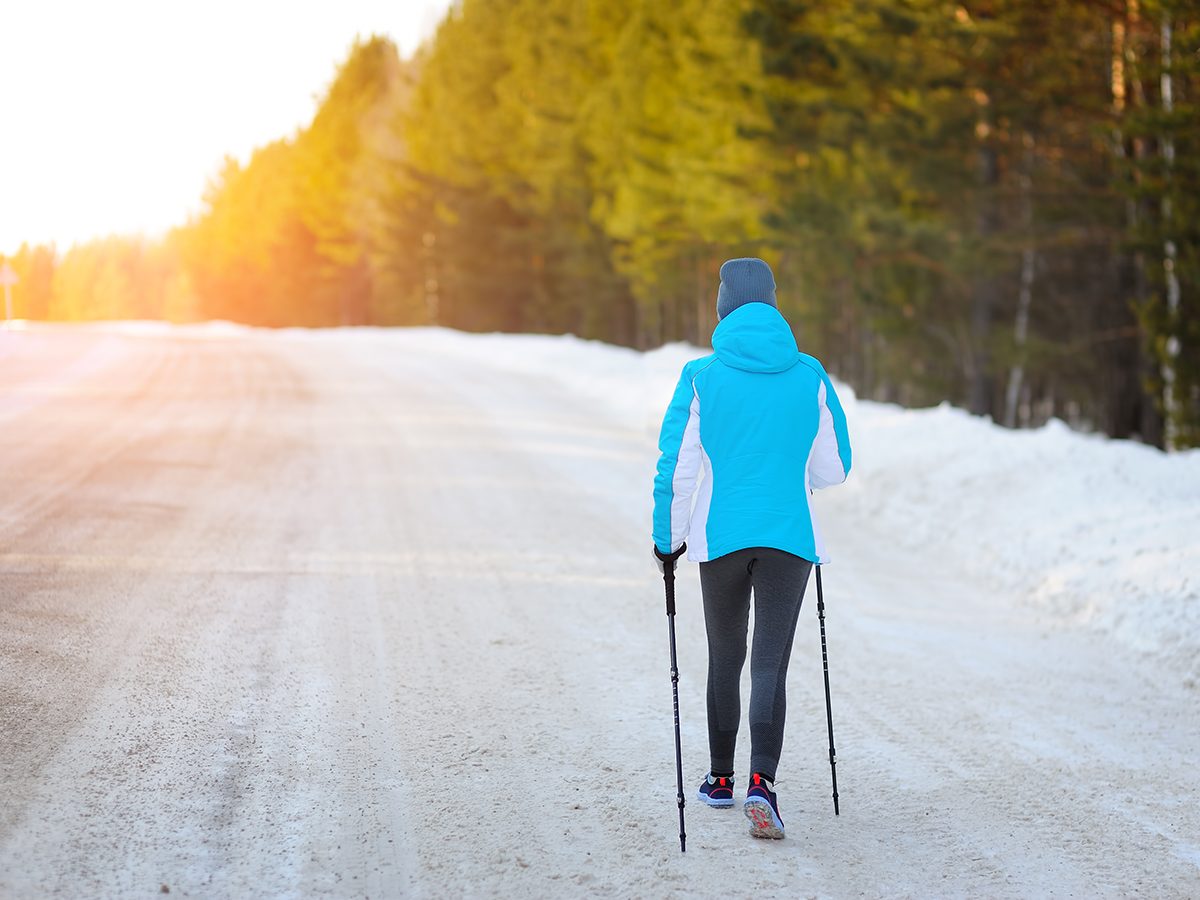9 Walking Mistakes You Didn’t Know You Were Making

Walking is a simple and effective type of exercise, but there are some common mistakes people make that can get in the way of your goals and even increase your risk of injury.
The most popular exercise for a reason
If you’re looking for a way to excuse-proof your exercise routine, look no further: Walking is not only a simple and effective way to stay physically active, it’s also a safer way to improve your health during the COVID-19 pandemic because you can exercise outdoors.
“The biggest benefit of walking is that it’s really accessible to just about everybody,” says Christopher John Lundstrom, PhD, MEd, director of sport and exercise science at the University of Minnesota School of Kinesiology.
It’s time efficient, you can do it almost anywhere, and you don’t need any specialized gear or clothes—just a pair of quality walking shoes with arch support and comfortable clothes. “Walking requires very little and can be done on the spur of the moment, too. You can get out even if it’s just for a few minutes.” (How safe is is to take a walk outside during COVID-19? This germ expert has the answers.)
And if you have a treadmill at home, you don’t even need to leave the house to reap the benefits.
Walking is also a low-impact activity, says Chris Gagliardi, personal trainer and scientific education content manager at the American Council on Exercise. That alone makes it a great exercise option for people with joint problems or other health issues that can make running and other high-impact exercises difficult.
“It is also highly adjustable—in terms of speed, incline, duration, and location—to meet the needs of all people,” Gagliardi says.
But what might be surprising is that there are a lot of common mistakes people make when walking for fitness. Some mistakes can lead to injuries. But even minor transgressions can make your walking less beneficial and less enjoyable—which can mess with your motivation and make it harder to develop a consistent routine.
Here are the most common walking mistakes and tips on how to fix them.

Wearing the wrong footwear
When it comes to avoiding injury, it’s essential to wear the best walking shoes for your feet, says Steven Jasonowicz, DPM, a podiatric foot and ankle surgeon at the Illinois Bone & Joint Institute.
He suggests wearing athletic sneakers that are supportive, feel good, and fit correctly.
“A lot of times people wear shoes that are not the correct size,” he says. “It’s important to go to a shoe store and get fitted for appropriately sized shoes.” Wearing ill-fitting shoes can cause rubbing, friction blisters, pinching in the toe box, and general foot pain.
If you’ve been fitted for shoes and still feel like your feet don’t have enough support, consider shoes with more cushioning and a stiffer sole, Dr. Jasonowicz suggests. This can help absorb some of the impact on your feet, and provide structural support for your feet and ankles. You may also benefit from an orthotic insert that can provide additional support. (Here’s more advice on how to choose the best pair for you.)
“It’s important to check your shoes regularly for spots that may cause friction and for breakdown—especially in areas that would be a safety concern, like the soles,” Gagliardi says. “A typical pair of athletic or walking shoes will last approximately 500 miles before needing to be replaced.”
It’s always a good idea to slowly break in any new shoes or orthotics. Wear them around the house or on short walks before you use them on a long walk to reduce the risk of rubbing and blisters. (Try these smart tricks to keep your shoes stink-free.)
If you have foot pain from walking and it doesn’t go away with new shoes, Dr. Jasonowicz recommends consulting a podiatrist to figure out what’s going on.
If you have diabetes, you should be extra cautious when it comes to selecting footwear because of the higher risk of diabetic neuropathy, which causes foot numbness, and complications like poor wound healing.
Swinging your arms too much—or too little
Use your arms to your advantage. When walking, your arms act as counterweights to your legs, says Lundstrom. And while it’s natural to move each arm with the motion of the opposite leg, “the movement should be just enough so your trunk isn’t moving back and forth and is nice and stable,” says Lundstrom. “The more vigourously you’re walking, the stronger your arm action is going to be. If you’re walking fairly leisurely, you don’t need very much arm motion.” (Here’s why you need to go for a walk every single day.)
Try to relax your arms and let them move naturally.

Straining your neck and shoulders
It’s also important to avoid tensing up. “Your shoulders should be loose,” Lundstrom says. “Over a few minutes, it’s not a big deal. But if you’re carrying tension in the shoulders and arms over 20 to 30 minutes, it can be uncomfortable and make walking a less pleasant experience.”
Try this: Every 10 minutes or so, check in and make sure your shoulders are loose and your arms are moving freely. It can also help to think about keeping your neck in a neutral position so that you’re not straining up or down. Think about relaxing your neck and keeping it in line with your spine, and set your gaze on the ground ahead of you, Lundstrom suggests. This will help your posture and reduce any discomfort. It will also help you scope out your footing. (Need relief from holiday stress? These exercises can help.)
Taking really wide steps
When walking, think about keeping your steps relatively close under your trunk, which is your centre of gravity, says Lundstrom. “You may be stepping out in front a little bit, but you don’t want to be overstriding and reaching really far in front of yourself.”
The reason: “It’s less stable, you’ll feel a little off balance, and if you plant your foot way in front of you, you’re basically hitting the brakes every time you land.” Over time, this extra force on your feet and legs can contribute to pain and overuse injuries like shin splints. (Here are the fall prevention tips all seniors should know about.)
You don’t need to overthink your walking style and every step you take. But focus on taking shorter, quicker steps if you’re trying to pick up the pace, rather than reaching your legs out far in front of your body, Lundstrom suggests. This will also help you keep your spine straight and in proper alignment to avoid putting extra stress on your back or hips.

Walking through the pain
As with any other form of exercise, it’s best not to push through pain when you’re walking. “Even with walking, you’re susceptible to things like stress fractures or other overuse injuries if you overdo it,” Dr. Jasonowicz says. This is especially true if you start off doing too much at once instead of letting your body slowly adapt to your new exercise program. (Watch out for these stomach pains you should never ignore.)
Going too hard right out of the gate can lead to soreness, discomfort, and—if you muscle through it—potentially an injury. Gagliardi suggests starting off with an amount of walking that you can comfortably complete and gradually increasing your distance and time over a period of weeks or months. “Especially if you are currently physically inactive, starting slow and low is important for reducing (risk of) injury,” he says. “More time, distance, and intensity can be added over time. But if you start out too fast and hard, you may risk an injury that could derail your new walking plan and decrease your motivation.”
If you’re having any sort of pain—in your feet, ankles, legs, hips—or you’re having trouble walking, see a doctor before continuing your exercise regimen. (Try these pain management tips for everyday aches.)
Walking at a too-low intensity
Walking doesn’t always have to be about getting an intense workout. Sometimes you simply want to go for a leisurely stroll without the pressure of turning it into a sweat session. There’s nothing wrong with that. But if your goal is to get your heart rate up and maximize the health benefits of your walk, Gagliardi suggests a moderate intensity. “Exercising at a moderate intensity is appropriate for most people and provides an effective stimulus to achieve health benefits.”
You can gauge your intensity a few ways but the easiest is by observing your breathing. “If you can talk but not sing during your walk, you are moving at a moderate intensity,” Gagliardi says. (Walking 10,000 steps a day? Here’s what’s happening to your body.)

Forgetting to hydrate
This is more or less critical depending on the temperature, says Lundstrom. “If you’re in a really warm, humid climate, think about carrying some fluids with you for a walk over 30 minutes. In a cooler environment, something more like an hour would be the threshold.” (Here’s 16 ways to lose weight walking.)
There’s no magic amount of water you need to drink to be hydrated. But carrying water with you and drinking a small amount at regular intervals is a good way to stay hydrated and avoid discomfort from drinking too much at once, says Gagliardi.
That’s also assuming you’re starting out well hydrated. “Make sure to take in some fluid an hour or two before you plan to walk, to make sure you are hydrated,” Lundstrom suggests. It’s also best to make it a habit to drink more water throughout the day, so that you’re not chugging it hastily right before you head out. You want to balance proper hydration with over-hydration and having to use the bathroom mid walk. (Don’t miss these 11 genius tricks to guarantee that you’ll drink enough water.)
Not having a plan
Safety should always come first. Whenever you head outside for a walk, it’s important to know where you are heading and how to get back, Gagliardi says.
“This may seem obvious, but it is important to know your route and how to get back or to a specific location. This is most important when walking in a new location.” (What’s better than taking a walk through the woods with your camera? Check out these 20 stunning nature photos from across Canada.)
Consider mapping out your walk beforehand, taking a picture of where you parked, or dropping a pin on Google Maps (on your phone) to tag your starting point, he suggests. Also, if you’re heading to a new place alone, it’s a good idea to always tell someone where you’ll be in case something happens and you need help.
Make sure you are choosing a route that’s safe and can help you avoid traffic. Choose brightly coloured or reflective gear when walking to make sure drivers can easily see you. And dress for the weather, choosing the right cold-weather jacket and other winter walking gear to stay warm and dry. (Winter can be challenging but here’s why cold weather is actually good for you.)
Listening to music that’s too loud
Listening to music, a podcast, or an audiobook is a great way to pass the time on a solo walk. But it’s important to always be aware of what is going on around you so you can stay safe.
“Listening to music while walking can improve performance, mood, and motivation,” says Gagliardi. But “it’s important to not have the volume of music so loud that you can’t hear what is going on around you.” This is obviously most important if you’re walking outdoors.
Gagliardi suggests putting just one earbud in and leaving the other ear empty so you can still hear your surroundings. “Awareness of your surroundings is crucial when exercising outdoors so that you can hear motorists, people, and animals,” he says.
Next, here’s 11 easy ways to make walking less boring.






